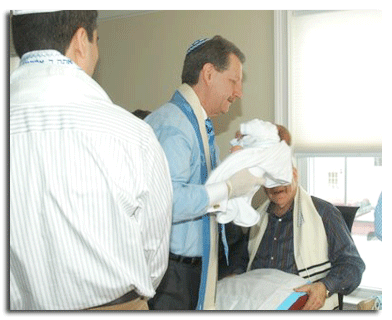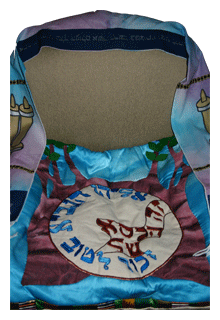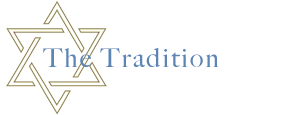The circumcision is a physical sign confirming the child’s covenant with G-d.
The Hebrew name is a spiritual sign binding his life to the Jewish people.
BRIT MILAH KODESH The holy covenant of circumcision
G-d further said to Abraham, “As for you, you and your offspring to come throughout the ages shall keep My covenant. Such shall be the covenant between Me and you and your offspring to follow which you shall keep: every male among you shall be circumcised. You shall circumcise the flesh of your foreskin, and that shall be the sign of the covenant that is between Me and you. And throughout the generations, every male among you shall be circumcised at the age of eight days.... And if any male ... fails to circumcise the flesh of his foreskin, that person shall be cut off from his kin; he has broken My covenant.” Genesis 17:9-14.
The Hebrew word for the divine covenant is ‘brit’ (or ‘bris’). A covenant requires the active participation from both members. Each makes a pledge; each accepts an obligation. Through their mutual aspirations a binding relationship is formed.
The Torah specifies three lasting covenants between G-d and man. The first is the covenant of the rainbow, which signifies G-d’s promise never again to destroy life upon the earth:
“When I bring clouds over the earth, and the rainbow appears in the clouds, I will remember My covenant between Me and you and every living creature among all flesh, so that the waters shall never again become a flood to destroy all flesh.” Genesis 9:14-15.
The second covenant is Shabbat, which serves as a sign of the creation and of man’s potential for holiness. The covenant of Shabbat is an act of consecration of granting man a measure of the Divine of allowing man to acquire holiness by his active participation in that which is holy.
“You must keep My Shabbat, for this is a sign between Me and you throughout the ages, that you may know that I the Lord have consecrated you....The Israelite people shall keep the Shabbat, observing the Shabbat throughout the ages as a covenant for all time.” Exodus 31:13-16.
This acquisition of holiness lies at the heart of the Jewish practice of mitzvot: by following G-d’s commandments, we become sanctified holy thus every blessing in Hebrew contains the words ‘ki-d'-sha-nu b'-mits-vo-tav’, which means ‘sanctifies us by the practice of His mitzvot’. In a sense, one becomes holy by acting holy. Viewed in this light, the mitzvot are not burdens, nor arbitrary rules which confine behavior; rather, they are opportunities given to us by the Lord to enable us to share in His divinity.
It is fitting that the supreme mitzvah is also the third of G-d’s covenants: the mitzvah of the Brit Milah, the covenant of circumcision. Unlike the rainbow and Shabbat, the sign of this covenant is marked in our very flesh. It is an inescapable reminder of the Jewish people’s unique relationship with the Lord, for by means of this covenant we enjoy a partnership with the divine. Circumcision serves as a physical sign of our devotion to the Lord.
To Jews and even non-Jews the Brit has served as a powerful symbol of all that is Jewish. Brit Milah has been practiced in an unbroken fashion by Jews for over 4000 years. Circumcision stands as a testimony to the longevity and invincibility of the Jewish people. It is for this reason that circumcision is usually among the first practices banned by those who have oppressed us. Our history is full of tales of heroism and martyrdom, in which simple Jews have placed their own lives, and those of their children, in great jeopardy in order to fulfill their part in the covenant with G-d.
 There is a story told by a man who survived the death camps of the Nazi holocaust. He tells of a woman who approached him one day as he was on a work detail outside of the camp. She demanded a knife. Before he could respond a guard approached, yelling out “Was machst du hier? (What are you doing here?)”. She saw an army field knife protruding from the guard’s pocket, and boldly demanded that he give it to her. Taken aback by her complete disregard for his authority, he gave her the knife. She walked over to a previously unnoticed bundle lying some twenty feet away and quickly unwrapping a small child performed a crude circumcision. She returned to the guard, handing him both the knife and her child, saying quietly “Now we can both die as Jews.” Despite adversity, the practice of Brit Milah has remained unbroken throughout the generations.
There is a story told by a man who survived the death camps of the Nazi holocaust. He tells of a woman who approached him one day as he was on a work detail outside of the camp. She demanded a knife. Before he could respond a guard approached, yelling out “Was machst du hier? (What are you doing here?)”. She saw an army field knife protruding from the guard’s pocket, and boldly demanded that he give it to her. Taken aback by her complete disregard for his authority, he gave her the knife. She walked over to a previously unnoticed bundle lying some twenty feet away and quickly unwrapping a small child performed a crude circumcision. She returned to the guard, handing him both the knife and her child, saying quietly “Now we can both die as Jews.” Despite adversity, the practice of Brit Milah has remained unbroken throughout the generations.
Circumcision is central to Judaism, preeminent among mitzvot. Brit Milah takes priority over Shabbat, Jewish Holidays (including Yom Kippur), funerals and weddings. It is often the only mitzvah practiced by non-observant Jews. The observant, rushing to perform a mitzvah at the earliest possible moment, practice Brit Milah as a part of their morning prayers. Whenever possible, this supreme mitzvah is an occasion for celebrating the joy and sanctification of life with friends and family.
Brit Milah is an act of completing, in partnership with G-d, the act of creation which is repeated at the time of every birth. It is a mark upon the organ of reproduction, that the seeds of the next generation are intimately related to the covenant of all those generations which have gone before.
IT IS A PERMANENT SIGN MARKED UPON OUR FLESH OF G-D’S LASTING COVENANT WITH US. BUT IT IS UP TO US TO DAILY REAFFIRM OUR COVENANT WITH G-D THROUGH ACTS OF MITZVOT, AND STUDY, AND PARTICIPATION WITHIN THE JEWISH COMMUNITY.
A Description of the rituals concerning Brit Milah
The Brit Milah is performed by the Mohel (Pronounced 'mo-hel' in Hebrew, 'moyl' inYiddish). The Mohel has received intensive instruction in the halacha (laws), minhagim (customs), brit (entry of a child into the covenant), and milah (surgical technique of circumcision). Any observant Jew who has mastered these skills may become a Mohel; one need not be a physician nor a Rabbi.
At the start of the Brit Milah ceremony the baby will be brought into the room by the Kvatter/Kvatterin (usually mistranslated as 'Godparents').The guests greet the baby in Hebrew with the words 'Bah-rooch hah-bah (Blessed be he who enters)'. The baby is held by his father during the introductory prayers.
The Kvatter/Kvatterin hold a position of honor and need not and usually are not the legal Godparents of the child. In order to increase the number of people honored during the Brit, it has become common for pairs of close friends or relatives (such as maternal and paternal Grandparents) to serve as Kvatter/Kvatterin.
After blessings in the throne of Elijah, the baby is now handed to one of the most honored people in the room: the Sandek. The Sandek has the privilege and the responsibility of assisting the Mohel during the circumcision. The Sandek should be an observant Jew who can testify that the Brit was performed in accordance with Jewish law. The high esteem that is placed on the Sandek is manifested by a special blessing and a position of honor standing next to the chair of Elijah.
It is the religious obligation of the father to perform the circumcision. The Mohel, due to his specialized surgical skills, acts on behalf of the father in actually performing the surgery. Medical knowledge is required to place the circumcision clamp. The placing of the clamp does not remove the foreskin; this must be performed with a knife. Excising the foreskin constitutes the actual mitzvah of the Milah and requires no special training. A father with exceptional fortitude and religious fervor performs a most wonderful mitzvah if he uses the knife (sometimes with the assist of the Mohel) and removes the foreskin himself.
After the circumcision is completed and the baby has been dressed, a brief naming ceremony will be performed. During this ceremony several prayers of thanksgiving are recited. Wine symbolizes the blood of the covenant (in other words, the physical act of circumcision), the forces of creation, and the sweetness of life. In receiving a Hebrew name the child is welcomed into the community of the Jewish people. The Brit is concluded with the bir-chot koh-hah-nim (the priestly blessings of the Kohanim), using the words which Aaron blessed the children of Israel after they received the revelation at Mount Sinai. (Numbers 6:24-26).
The Grace after Meals is said after the celebratory meal. Often this is lost and forgotten in the presence of the high emotions and general confusion which seems to accompany any important life cycle event. I have taken the liberty of inserting several of the more inspiring blessings from the Grace into the body of the Brit Milah ceremony.

